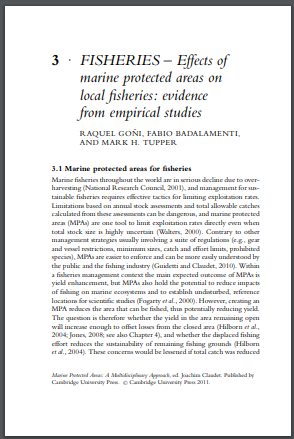
Marine fisheries throughout the world are in serious decline due to overharvesting (National Research Council, 2001), and management for sustainable fisheries requires effective tactics for limiting exploitation rates. Limitations based on annual stock assessments and total allowable catches calculated from these assessments can be dangerous, and marine protected areas (MPAs) are one tool to limit exploitation rates directly even when total stock size is highly uncertain (Walters, 2000). Contrary to other management strategies usually involving a suite of regulations (e.g., gear and vessel restrictions, minimum sizes, catch and effort limits, prohibited species), MPAs are easier to enforce and can be more easily understood by the public and the fishing industry (Guidetti and Claudet, 2010). Within a fisheries management context the main expected outcome of MPAs is yield enhancement, but MPAs also hold the potential to reduce impacts of fishing on marine ecosystems and to establish undisturbed, reference locations for scientific studies (Fogarty et al., 2000). However, creating an MPA reduces the area that can be fished, thus potentially reducing yield. The question is therefore whether the yield in the area remaining open will increase enough to offset losses from the closed area (Hilborn et al., 2004; Jones, 2008; see also Chapter 4), and whether the displaced fishing effort reduces the sustainability of remaining fishing grounds (Hilborn et al., 2004). These concerns would be lessened if total catch was reduced.






